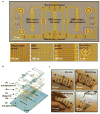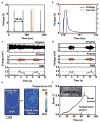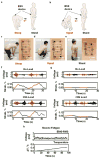An Epidermal Stimulation and Sensing Platform for Sensorimotor Prosthetic Control, Management of Lower Back Exertion, and Electrical Muscle Activation
- PMID: 26469201
- PMCID: PMC4833675
- DOI: 10.1002/adma.201504155
An Epidermal Stimulation and Sensing Platform for Sensorimotor Prosthetic Control, Management of Lower Back Exertion, and Electrical Muscle Activation
Abstract
The design of an ultrathin, conformal electronic device that integrates electrotactile stimulation with electromyography, temperature, and strain sensing in a single, simple platform is reported. Experiments demonstrate simultaneous use of multiple modes of operation of this type of device in the sensorimotor control of robotic systems, in the monitoring of lower back exertion and in muscle stimulation.
Keywords: electromyography, sensorimotor control; electrostimulation; epidermal sensors; ultrathin electronics.
© 2015 WILEY-VCH Verlag GmbH & Co. KGaA, Weinheim.
Figures





References
-
- Xu S, Zhang Y, Jia L, Mathewson KE, Jang KI, Kim J, Fu H, Huang X, Chava P, Wang R, Bhole S, Wang L, Na YJ, Guan Y, Flavin M, Han Z, Huang Y, Rogers JA. Science. 2014;344:70. - PubMed
-
- Budinger TF. Annu Rev Biomed Eng. 2003;5:383. - PubMed
-
- Tee BCK, Wang C, Allen R, Bao Z. Nat Nanotechnol. 2012;7:825. - PubMed
-
- Jeong JW, Yeo WH, Akhtar A, Norton JJS, Kwack YJ, Li S, Jung SY, Su Y, Lee W, Xia J, Cheng H, Huang Y, Choi WS, Bretl T, Rogers JA. Adv Mater. 2013;25:6839. - PubMed
Publication types
MeSH terms
Grants and funding
LinkOut - more resources
Full Text Sources
Other Literature Sources

